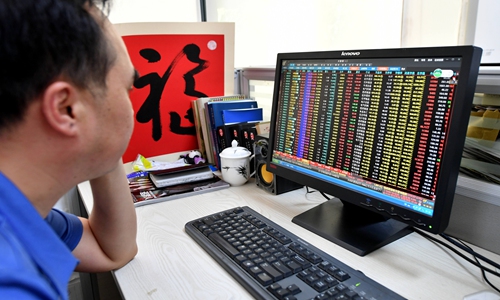
An investor tracks A-share performance in Fuzhou, capital of East China's Fujian Province, on Monday. Photos: CNSphoto
China's flagship Shanghai Composite Index is on course to hit its year-to-date high as the market prices in an imminent move to align A shares with their global counterparts, parts of a broad effort to match the nation's economic muscle.
The benchmark Shanghai Composite Index finished up 0.36 percent at 3,451.09 points on Tuesday, nearing 3,458.79 points - its highest intraday level for the year to mid-July.
The benchmark's gains attest to the expectation of a more vibrant market after the forthcoming debut of the first batch of registration-based IPOs in the ChiNext market in Shenzhen. The move is an effort intended to put mainland shares one step closer to being on a par with their international peers.
The Shenzhen Stock Exchange announced late Friday that the initial batch of registration-based IPOs will trade on August 24, meaning all stocks on the ChiNext board will be allowed to rise and fall by 20 percent in a single trading day, as opposed to the existing daily trading limit of 10 percent.
Stocks on the technology-centric STAR market in Shanghai have adopted the 20 percent trading limit for more than a year. By August 24, roughly one-third of stocks traded on the mainland market will be subject to the 20 percent trading limit.
Reforms of the trading mechanism arguably bode well for the A-share market, Raymond Deng, investment strategist CIO of consumer investment and insurance products at DBS Bank, told the Global Times on Monday.
The introduction of the registration-based IPO system is "a fairly good step" to start with, which should be followed by others such as securities settlements on a T+0, or same day, basis, and revisions to the current 10 percent daily trading limit at large, Deng said.
"Existing trading limits have shown themselves to be less and less in step with a market opening its doors wider to foreign investors," Deng added, saying he expected deregulation in this regard to spur trading volumes and make mainland shares more attractive to overseas investors in particular.
Securities settlement on a T+1 basis - meaning shares cannot be sold until during and after the next trading day - and a 10 percent daily trading limit have both been part of the A-share market since late last century.
"The trading rules were a product of the market environment at the time," said Wei Fengchun, chief macro strategist of Bosera Asset Management Co. "But for three decades after the two bourses were established in the early 1990s, investors became increasingly financially savvy," Wei added.
The push for China's A-share market to take the lead across the globe therefore necessitates the adoption of internationally acknowledged trading rules, such as an expansion of trading limits and the introduction of same-day settlement.
But the drive toward aligning A shares with their global peers should not be too hasty, Wei warned, noting that allowing same-day settlement, revoking daily trading limits, and offering short-selling portfolios in an effort to globalize A shares ought to be slowly introduced into the market.
Xiao Gang, former chief of China's securities regulator, has offered a possible solution for globalizing mainland stocks.
T+0 settlement is a basic system that's been widely adopted in overseas capital markets, but it's yet to be allowed in the mainland stock market, the Securities Times reported over the weekend, citing an interview with Xiao.
Out of 44 major global markets, 42 green-lit T+0 settlement, according to data from the International Securities Services Association.
The same-day settlement, an option for future reforms of the trading regime, could first be piloted among blue-chips in the A-share market to offset the risk of inducing wild swings, according to Xiao. The mainland stock market remains mostly composed of retail investors who could easily lose money in T+0 trades.
As for market prospects, Wei reckons that the tweak to trading rules tends to affect a stock's price in the short term, but is unlikely to impact its true invest-worthiness. Signs of a weaker economic recovery, as indicated by a raft of data for July, plus the marginal effects of monetary easing on the stock market that appear to be tapering off, are considered two major factors that weigh on stock market performance, he said.
Technology stocks traded on the ChiNext board, tasked with the economy's rebalance toward being driven by technological innovation, are likely to embrace a structural rally, with those truly representing the future of the nation's competitiveness and steadily increasing earnings expected to continue an upward spiral in valuation terms, according to Wei. Those mired in overvaluation concerns yet with miserable earnings would instead see investors voting with their feet as discarded options.
The linchpin of whether a bull run or a bearish rally sets in lies in listed firms' earnings growth, the strategist stressed.
"I would probably be taking a wait-and-see approach initially after the new trading rule takes effect," said a retail investor giving her surname as Ji.
She wouldn't opt to up the ante unless she's assured that risks associated with the trading limit expansion are controllable, Ji told the Global Times.
The nation's push for stock market sophistication underpins her "cautious optimism" about A shares, she said, noting that individual investors are set to face greater risks, thereby entailing more efforts to get a deeper understanding of the stocks to buy and to pick out truly premium companies.




